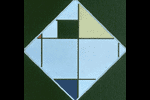|
"Study in Paris, just before World War I,
introduced Mondrian to modes of abstraction in avant-garde
art such as Cubism. However, as his attraction to
contemporary theological writings grew, Mondrian sought to
purge his art of every overt reference to individual objects
in the external world."
- Gardner's
Art Through The Ages,
11th edition, Vol. II, p. 1048
Seascape

"Mondrian soon moved beyond Cubism
because he felt 'Cubism did not accept the logical
consequences of its own discoveries; it was not developing
towards its own goal...' ... Mondrian eventually limited his
formal vocabulary to the three primary colors (red, blue,
and yellow), the three primary values (black, white, and
grey), and the two primary directions (horizontal and
vertical). Basing his ideas on a combination of
teachings, he concluded that primary colors and values are
the purest colors and therefore are the perfect tools to
help an artist construct a harmonious composition.
Using this system, he created numerous paintings locking
color planes into a grid of intersecting vertical and
horizontal lines... In each of these paintings,
Mondrian altered the grid patterns and the size and
placement of the color planes to create an internal cohesion
and harmony. This did not mean inertia; rather,
Mondrian worked to maintain a dynamic tension in his
paintings from the size and position of lines, shapes, and
colors."
- Gardner's
Art Through The Ages,
11th edition, Vol. II, p. 1049
Composition / Red Square

Diagonal Composition

|